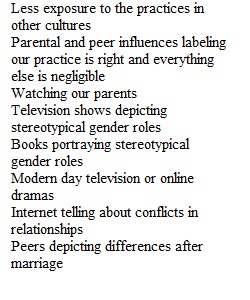


Q A) In this first step, do your best to identify three of your biases on marriage due to your culture and religion. The American culture and legal system generally allowonlyone type of marriage. What type of bias does this embed in us? The religions that people belong to and practice can also impact their biases toward marriage, depending on how their chosen religion defines marriage. How does this influence your perspective of marriage in general? How does this bias influence your perspectiveon these specific types ofmarriage?B) While it is impossible to “check our culture and biases at the door” and become totally objective, we can identify our biases (as you have already done above) and try to ignore them in order to consider other points of view. In this next step, take a culturally relativistic standpoint (in other words, try to overcome your biases) and consider the tenets of each type of marriage. Why might these other forms of marriage be more successful or advantageous in certain contexts than the Western concept of marriage (based on love and monogamy)? Then, from that same culturally relativistic standpoint, also consider some possible drawbacks to these forms of marriage.C) Create a question:In this learning block, you were given a lot of information about marriage and what marriage means in different cultures. You were also asked to think about what marriage means to you.The next step is to take the information you have been given and create a question a social scientist might ask to further the investigation of marriage. For example, after reading about arranged marriages, you might ask: Are rates of depression higher in women in arranged marriages? Social scientists use existing information to come up with new questions. This is the iterative process of social science research.
View Related Questions